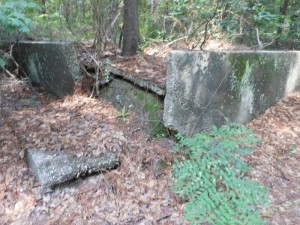
There are foundations from a former Civilian Conservation Corps located on the road to Hinson Lake from East Washington Street. They are in the turn around area on the right.
Federal programs shape Richmond County today
Farming and forestry are the largest industries in Richmond County. Are we just lucky?
If not for our past, where would we be today is a question often asked by the Richmond County Historical Society.
The land in the county has undergone changes both bad and good since the pioneers arrived in the 1700s.
Bad when the once fertile land began to erode by early practices in farming; and trees, once abundant, were cut leaving barren land.
Good changes have taken place since then through constant efforts of state and federal offices in Richmond County.
During the Great Depression of the 1930s, the Civilian Conservation Corps was established to offer jobs to unemployed men to help local farmers save their eroding land.
Richmond County had two such camps.
A visible reminder of the CCC in Rockingham can be seen in the cement foundations at Hinson Lake today at a small parking area on the west side of the road to the lake.
There almost wasn’t a CCC camp in Rockingham. It was originally endorsed by the Rockingham Merchants Association.
Then it was announced the camp would be for Negro men. The Richmond County Journal, July 10, 1935: “Citizens of the town are debating, sometimes rather heatedly, whether location of CCC camp on the outskirts would be worthwhile to the community.”
The merchants met again to reconsider their endorsement and stood by it. They would benefit economically from the camp. It began operation Aug. 16, 1935.
There were up to 250 men there at its peak supervised by U.S. Army officers. Housing was erected for them. They worked with farmers on soil erosion projects.
The men performed so well providing beneficial service to farms that when the federal government began closing camps, local farmers rallied for the camp’s survival.
The camp had set the mood for greater adherence by example with conservation methods which continue today. Efforts by the CCC led to the feasibility, refinement and improvement of conservation measures. That statement was made in 1985 by the “Journal of Soil and Water Conservation.”
Many people may curse the federal government now for a variety of reasons, much of it sometimes deserved when good intentions are derailed by politics and/or bureaucracy.
Even so, we in Richmond County have much to thank for our share of federal funds for the airport, roads, water and sewer systems and other grants of many kinds, as well as the land conservation efforts.
In August 1939, the Rockingham camp was relocated to Concord where the need was greater.
The Hoffman CCC camp, located just inside the present entrance to the Sandhills Game Land on U.S. 1 north, opened in 1939 and closed in July 1941.
The CCC was one of the early, though short-lived, federal programs trying to reinvigorate Richmond County. The Works Project Administration was working in the same area of Hoffman renewing decimated forests which the Sandhills Project in 1938 purchased (some 58,900 acres) which is now part of the game land.
McKinney Fish Hatchery and many lakes in the game land were created by these Hoffman area programs which enhanced our natural resources today considered among the attractions in Richmond County.
This is background, or history, for the county’s active state and private forestry program. Sandhills Game Land is a large portion of Richmond County, but there is actually much more private forest land.
In addition to the game land office, we have a District Office of N.C. Forest Services here. It is serious business.
Serious farming is done in cooperation with offices that compose the Farm Service Agency in Rockingham.
As a county, we owe a debt of gratitude to these programs and the men and women who administer them. It is all part of our local history, and influences who we are today.
Tom MacCallum
